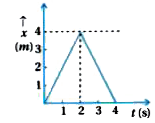A body with mass 5 kg is acted upon by a force F=(3i+4ˆj) N. If its initial velocity at t = 0 is v=6i−12ˆjms−1 , the time at which it will just have a velocity along the Y-axis isSolution in Gujrati
never
10 s
2 s
15 s
The correct Answer is:B
10 s
mass m = 5 kg
force = F= (3ˆj+4ˆj)N
Initial velocity at t=0
Acceleration →a=→Fm=(−3ˆj+4ˆj5
v=u+at
=(6ˆj−12ˆj)+(−35ˆj+45ˆj)t
Final velocity is along y -direction x - comp of final velocity = 0
3t5=6
t=5×63=10sec
Topper's Solved these Questions
- LAW OF MOTIONBOOK - KUMAR PRAKASHANCHAPTER - LAW OF MOTIONEXERCISE - SECTION -E(MULTIPLE CHOICE QUESTIONS) (MCQS)
69 Videos
- LAW OF MOTIONBOOK - KUMAR PRAKASHANCHAPTER - LAW OF MOTIONEXERCISE - SECTION-F (QUESTIONS FROM MODULE)
22 Videos
- LAW OF MOTIONBOOK - KUMAR PRAKASHANCHAPTER - LAW OF MOTIONEXERCISE - SECTION-C(OBJECTIVE QUESTIONS) (VSQS)
55 Videos
- GRAVITATIONBOOK - KUMAR PRAKASHANCHAPTER - GRAVITATIONEXERCISE - QUESTIONS PAPER Section - D
1 Videos
- MACHANICAL PROPERTIES OF SOLIDS BOOK - KUMAR PRAKASHANCHAPTER - MACHANICAL PROPERTIES OF SOLIDS EXERCISE - QUESTION PAPER
11 Videos
Similar Questions
The position (x) → time (t) graph of one dimensional motion of a body of mass 0.4 kg. What is the magnitude of impulse of force

View SolutionA block rests on a rough inclined plane making an angle of 30° with the horizontal. The coefficient of static friction between the block and the plane is 0.8. If the frictional force on the block is 10 N, the mass of the block ((in kg) is .......... (Take g = 10 m/s2)
View SolutionArea of F → t graph gives which physical quantity ?
View SolutionA spaceship is stationed on Mars. How much energy must be expended on the spaceship to launch it out of the solar system ? Mass of the spaceship = 1000 kg, mass of the sun =2×1030kg, mass of mars =6.4×1023kg, radius of mars = 3395 km, radius of the orbit of mars =2.28×108km,G=6.67×10−11Nm2kg2
View SolutionWhat is called brittle material ?
View SolutionA body of mass 10 kg is being acted upon by a force 3t2 and an opposing constant force of 32 N. The initial speed is 10ms−1.The velocity of body after 5 s is
View SolutionA body with mass 5 kg is acted upon by a force vec(F) = (- 3 hat (i) + 4 hat (j)) N . If its initial velocity at t =0 is vec(v) = 6 hat(i) - 12 hat (j) ms^(-1) , the time at which it will just have a velocity along the y-axis is :
View SolutionA body of mass 5 kg is moving with velocity of v=(2ˆi+6ˆj)ms−1 at t=0s. After time t=2s, velocity of body is (10ˆi+6ˆj), then change in momentum to body is
View SolutionA force of (2.6 hat(i) + 1.6 hat(j)) N acts on a body of mass 2 kg. If the velocity of the body at time, t = 0 is (3.6 hat(i) - 4.8 hat(j)) ms^(-1) , the time at which the body will just have a velocity along x-axis only is
View SolutionAn object with mass 5 kg is acted upon by a force, vecF = (-3hati + 4hatj) N. If its initial velocity at t = 0 is vecv = (6hati – 12hatj) m s^(-1) , the time at which it will just have a velocity along y-axis is
View SolutionA body of mass 5 kg is acted upon by a constant force→F=(−3∧i+6∧j)NIts initial velocity at t = 0 is→u=(6∧−2∧ms−1 what is its velocity after 5s ? What is its magnitude ?
View Solution5 किग्रा के एक पिण्ड पर →F=(−3ˆi+4ˆj)N का बल क्रियाशील है। यदि t = 0 पर इसका आरंभिक वेग ˆu=(6ˆi−12ˆj) मी/से है, तो वह समय जिस पर इसका ठीक y-अक्ष के अनुदिश वेग होगा -
View SolutionA force on a body of mass 5 kg F = (-3hati+4hatj) Newton is working. If the initial velocity of the body at t = 0 v = (6hati-12hatj) M / s, then the time when its velocity is only along the y-axis is
View SolutionA body with mass 5 kg is acted upon by a force →F=(−3ˆi+4ˆj)N. If its initial velocity at t =0 is →v=(6ˆi−12ˆj)ms−1, the time at which it will just have a velocity along the y-axis is :
View SolutionA body with mass 5 kg is acted upon by a force →F=(−3ˆi+4ˆj)N. If its initial velocity at t =0 is →v=6ˆi−12ˆjms−1, the time at which it will just have a velocity along the y-axis is :
View Solution
